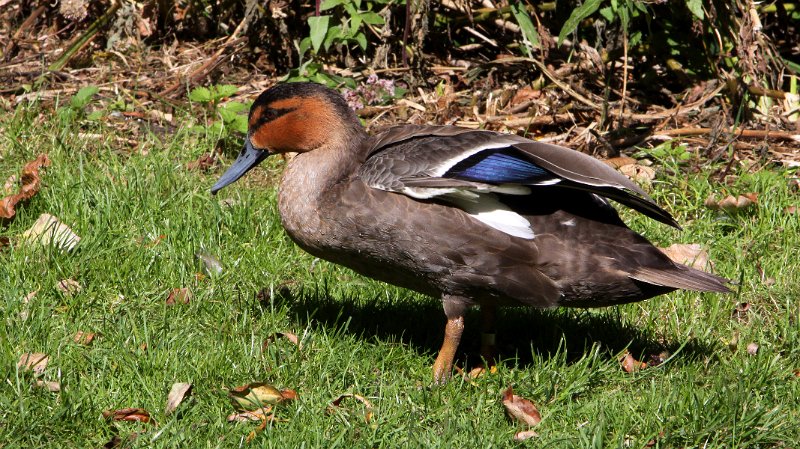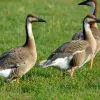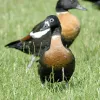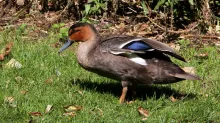
Philippine Duck (Anas luzonica)
Naamgeving
- Nederlandse naam:
- Filippijn eend
- Engelse naam:
- Philippine Duck
- Duitse naam:
- Philippinenente
- Franse naam:
- Canard des Philippines
- Wetenschappelijke naam:
- Anas luzonica
Taxonomische indeling
- Orde:
- Anseriformes
- Familie:
- Anatidae
- Onderfamilie:
- Anatinae
- Geslacht:
- Anas
Beschrijving
- Uiterlijke kenmerken:
Male:
With its rusty-cinnamon head and bluish-grey bill, the Philippine duck is a rather distinctive bird. The cinnamon colored head is boldly decorated with a black crown and a black stripe through the eye, while the rest of the plumage is brownish-grey. When in flight, a well-defined patch of glossy green on the wing can be clearly seen, which is bordered with black and has a narrow white edge, and the underside of the wing is also white.Female:
As Male, But female is slightly smaller in all aspects by 10 %Juvenile:
Have slightly duller plumage than that of adults.
- Gedrag:
Usually found as pairs or in small groups, but sometimes in larger flocks of 100-200 birds. Pair-bonds may be strong longer lasting rather than seasonal.
Maten en Gewicht
- Lengte man:
- De man (woerd) van de Philippine Duck heeft een lichaamslengte van ongeveer 48-58 centimeters. De vrouw (pop) heeft een lichaamslengte van ongeveer 48-58 centimeters.
- Gewicht man:
- Het mannetje weegt ongeveer 800-980 gram. Het vrouwtje weegt ongeveer 725-820 gram.
Het gewicht is notoir variabel en kan alleen als indicatie worden gebruikt!
- Notitie:
Dabbling Ducks are generally hardy, easy to maintain and easy to breed. Shelter may be required by some of the smaller species in winter. They should be provided with cover (including marginal pond cover) and loafing areas as well as water. A pen which is 50% water is suggested. The water may be shallow (i.e. no more than two feet deep is required), and muddy areas for dabbling in are also appreciated. These ducks are generally good in mixed collections, although the smaller and quieter species may be bullied. Territorial disputes between ducks of the same species may be avoided by keeping only one pair of each species in an enclosure, unless the area is very large. For a single pair of ducks a pen are of 50 to 100 square metres, depending on the size of duck, should be provided.
A diet based on wheat and pellets is suggested, with maintenance pellets changed to breeders pellets for the breeding season. Bread and greenfood are also appreciated. Grit should always be available, with soluble grit (e.g. oystershell grit) as a calcium source when breeding.
Most species are ground nesters and both close ground cover and ground level nest boxes should be provided. Hand-rearing is generally preferred, as these ducks are generally poor parents in captive conditions, particularly in enclosures shared with other waterfowl. These ducks are prone to hybridization, particularly with closely related species, which should be kept apart from one another.
Philippine ducks are fairly winter-hardy and easy to manage. The enclosure should provide water, loafing areas and cover. They are suitable for mixed collections, although there may be problems with drake Mallard (Anas platyrhynchos) attempting to pair with ducks. Feed as other dabbling-ducks, with grain and pellets.
These ducks are easily bred. They may nest in natural close ground cover, ground level or raised nest box, shelters or baskets, eggs laid from April to June. The ducklings are straightforward to rear. A duck may rear two broods in one season; starter crumbs supplemented with duckweed and finely chopped grass suggested.
Prone to hybridisation within the '"mallard" group; hybrids reported with Mallard (Anas platyrhynchos) and Pacific black duck (Anas superciliosa).
- Breeding:
- Het vrouwtje Philippine Duck legt doorgaans zo'n 8-12 pale green eieren het broeden duurt 25-26 dagen.
- Kunstmatig broeden:
De ideale relatieve luchtvochtigheid voor het uitbroeden van de meeste watervogeleieren is 55% voor grondbroeders en 40% bij holenbroeders. De temperatuur is meestal 37,4° C. Stel ventilatie in zoals aanbevolen door de fabrikant van de broedmachine. Eieren moeten minimaal 4 keer per dag automatisch of met de hand worden gedraaid. Naarmate de vrucht zich ontwikkelt, verliest het ei water en wordt de luchtzak groter. Bij normale ontwikkeling van een ei met een incubatietijd van 25-26 dagen neemt de luchtzak ongeveer een derde van het ei in beslag, dit bij drie dagen voor uitkomst. Reinheid is van vitaal belang en idealiter moet de luchtvochtigheid worden verhoogd tot 65% nadat de eerste tekenen van uitkomst zichtbaar worden.
- Ringdagen:
- Aanbevolen passende ringmaat voor de Philippine Duck is 11 mm.De gesloten pootring kan alleen aangebracht worden bij een jonge dabbling duck van ongeveer 12-14 dagen oud.
- It doesn't matter what leg that you band, but it's good to have a consistent system. Suggested: Left leg = Female, Right leg = Male
- Onderhoudsvoeder:
-





Lundi Regular with a protein content of 20%, valuable Spirulina and high-quality by-products is optimally balanced in its composition maintenance food for water ornamental fowl of all kinds. Especially green teal and Whistling ducks that are not dependent on a very high protein content, are well supplied.
Lundi Regular contains all the minerals and vitamins in full form that are important for the animals. Therefore also suitable as breeding food.





Floating full food for all sea ducks, green ducks, eider ducks and geese, especially in the moulting and breeding phase ideally suited. Packed with wholesome raw materials, natural vitamins and trace elements, this performance food with a protein content of 30% forms the basis for lifelong vitality.



